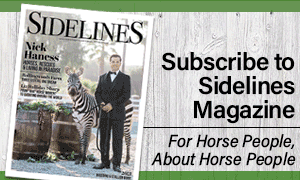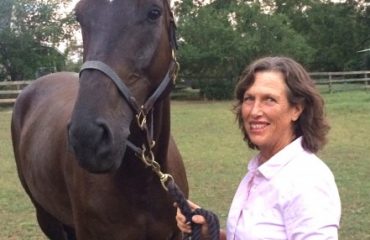By George Williams
For many, the terms contact and connection are interchangeable. It’s often said that a picture is worth a thousand words, and similarly, in riding, a correct feeling can help us fully understand a single word. In dressage, contact and connection, like so many concepts and words, are best understood once a rider has experienced the feeling under saddle. For me, it’s more understandable if we separate the two terms. While the actual terms are very related, one is a more basic term and is the foundation for the other. To put it simply, connection is a quality you can develop once the horse understands contact. Likewise, when the connection is well established, the rider can then determine the sensitivity of the contact.
To start with, let’s look at ways contact is referenced in what I suspect to be three of the most under-utilized resources we have available to us: the USDF Glossary of Judging Terms along with the “Pyramid of Training,” and the dressage portions of the US Equestrian and FEI Rulebooks.
The USDF has this to say about contact and connection: “The energy generated in the hindquarters by the driving aids must flow through the whole body of the horse and is received in the rider’s hands. The contact to the bit must be elastic and adjustable, creating fluent interaction between horse and rider with appropriate changes in the horse’s outline.” Ultimately, the line between connection and thoroughness becomes blurred in a good manner, in my opinion making it obvious why impulsion is the next step in the training scale.
The dressage portion of the USEF Rule Book describes being “on the bit” as “accepting the bridle with a light and consistent soft submissive contact.” A little later, when describing the qualities of the halt, it states, “While remaining ‘on the bit’ and maintaining a light and soft contact with the rider’s hand, the horse may quietly chew the bit and should be ready to move off at the slightest indication of the rider.”
Under the description of submission, the FEI Rulebook says, “The degree of the submission is also demonstrated by the way the Horse accepts the bit, with light and soft contact and a supple poll.”
Light and soft contact is the ideal. Combine this with being ready to move off at the slightest indication of the rider, and we’ve connected the power of the hind legs to a light and soft contact. Bingo — we have connection!
Developing the proper contact can be frustrating, sometimes even maddening. Over the years, one hears numerous descriptions of what the perfect light and soft contact should be: “It’s the weight of the reins in hands,” “Close your fist as if you’re holding a baby bird in it,” or, “It should feel like butter.”
As an instructor, describing how to achieve contact to those who may not have a natural feel can be challenging — or even maddening as well. Phrases like “take and give,” “close your fingers,” “slight vibration,” and “hands steady but never still” are all a part of it but not completely accurate. Nor do they tell the whole story of how to achieve an animated contact. I have recently settled on “in communication” because in the end, you have to be able to touch the reins in a manner that solicits the response you want. It has to be attractive and appealing to the horse so they seek the contact and willingly go forward to the bit.
Sometimes you hear a clinician say, “I don’t do anything with my hands,” “My hands are just there,” or “I ride my horses forward into my hands.” This can be slightly misleading as well. Certainly, most of the time your hands should be considered supporting aids. No matter how subtle, they must always be in communication with the horse and able to support your seat and legs in regulating the balance, tempo and alignment of the horse.
Not too long ago, it seemed that one of the most common comments on a dressage test was “constant contact.” In my mind, this can also be a slightly misleading term. What does it mean, and is it easily misinterpreted? The horse needs to go consistently forward into a consistent contact. Your horse should seek the contact, but remember the Rulebooks say the horse accepts the bit with a “light and soft contact.” That means not pulling down, with the rider holding him up, nor pulling the rider through the test, or the rider pulling back on the reins to maintain a certain carriage or frame. Under the description of contact, the USDF addresses this by going on to say, “The quality of the connection and balance can be evaluated by releasing the reins to demonstrate self-carriage….”
So, what are the visuals of whether the contact is good and the connection is truly functioning properly? There are many, including the length of neck, swinging back, a relaxed tail and consistent rhythm and tempo. The most obvious visuals of when there are problems include the horse opening his mouth, putting his tongue out and resistance to the hand. It should come as no surprise that cranking the noseband or tightening a curb chain does not fix the core problem — correcting the contact and the resulting connection is the better solution.
Today, a judge said of the winning Grand Prix special ride at the Global CDI5*, it was “from his mouth, to her hand, to her heart.” That, my friends is the contact we should all aspire to for the right kind of connection to our horse’s heart.
Dressage rider Nick Wagman demonstrating contact and connection.
Photo by Melissa Fuller













